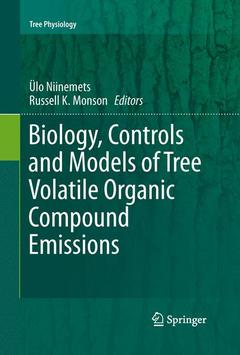Description
Biology, Controls and Models of Tree Volatile Organic Compound Emissions, Softcover reprint of the original 1st ed. 2013
Tree Physiology Series, Vol. 5
Coordinators: Niinemets Ülo, Monson Russell K.
Language: English
Subjects for Biology, Controls and Models of Tree Volatile Organic...:
Publication date: 08-2015
Support: Print on demand
Publication date: 07-2013
547 p. · 15.5x23.5 cm · Hardback
Description
/li>Contents
/li>Comment
/li>
Plant-driven volatile organic compound (BVOC) emissions play a major role in atmospheric chemistry, including ozone and photochemical smog formation in the troposphere, and they extend the atmospheric lifetime of the key greenhouse gas, methane. Furthermore, condensation of photo-oxidation products of BVOCs leads to formation of secondary organic aerosols with profound implications for the earth's solar radiation budget and climate. Trees represent the plant life form that most contributes to BVOC emissions, which gives global forests a unique role in regulating atmospheric chemistry.
Written by leading experts in the field, the focus is on recent advancements in understanding the controls on plant-driven BVOC emissions, including efforts to quantitatively predict emissions using computer models, particularly on elicitation of emissions under biotic and abiotic stresses, molecular mechanisms of volatile synthesis and emission and the role of emissions in plant stress tolerance.
Preface.- Chapter 1 Diversification of Volatile Isoprenoid Emissions from Trees: Evolutionary and Ecological Perspectives.- Chapter 2 BVOC Mediated Plant-Herbivore Interactions.- Chapter 3 The Biochemistry and Molecular Biology of Volatile Messengers in Trees.- Chapter 4 Genetic Engineering of BVOC Emissions from Trees.- Chapter 5 Molecular and Pathway Controls on Biogenic Volatile Organic Compound Emissions.- Chapter 6 Metabolic and Gene Expression Controls on the Production of Biogenic Volatile Organic Compounds.- Chapter 7 The Roles of Stomatal Conductance and Compound Volatility in Controlling the Emission of Volatile Organic Compounds from Leaves.- Chapter 8 The Role of Volatile Organic Compounds in Plant Resistance to Abiotic Stresses: Responses and Mechanisms.- Chapter 9 Flooding-driven emissions from trees.- Chapter 10 Modification of BVOC Emissions by Changes in Atmospheric [CO2] and Air Pollution.- Chapter 11 Multitrophic Signalling in Polluted Atmospheres.- Chapter 12 Leaf-Level Models of Constitutive and Stress-Driven Volatile Organic Compound Emissions.- Chapter 13 Scaling BVOC Emissions from Leaf to Canopy and Landscape: How Different Are Predictions Based on Contrasting Emission Algorithms?.- Chapter 14 Upscaling Biogenic Volatile Compound Emissions from Leaves to Landscapes.- Chapter 15 Scaling Emissions from Agroforestry Plantations and Urban Habitats.- Chapter 16 Global Modeling of Volatile Organic Compound Emissions.- Chapter 17 Climate Feedbacks Linking the Increasing Atmospheric CO2 Concentration, BVOC Emissions, Aerosols and Clouds in Forest Ecosystems.- Chapter 18 State-of-the-art of BVOC research: what do we have and what have we missed? A Synthesis.




